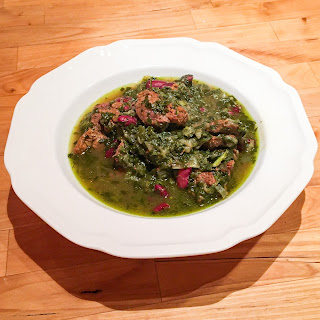Khoresh-e Bademjoon (Persian Lamb, Eggplant and Tomato Stew)
New: May 2020
2 pound boneless lamb shoulder, trimmed and cut into 2-inch cubes
3 heaping teaspoon ground turmeric
Fine sea salt and freshly ground black pepper
12-16 Japanese eggplants (about 4 pounds) Indian or chinese egg plants ok too
10 tablespoons plus 1/2 cup olive oil
2 large yellow onion, thinly sliced
8 small or 4 medium tomatoes (about 2 pounds)
6 tablespoons tomato paste
½ teaspoon crumbled saffron threads
½ teaspoon cinnamon
½ -1 cup freshly squeezed lime juice (from 2 to 4 limes)
2/3 cup fresh or frozen unripe grapes (ghooreh)
PREPARATION
1. In a large bowl, season lamb with turmeric, 1.5 teaspoon salt and 1 teaspoon pepper. Set aside.
2. Peel the eggplants. Place eggplants in a colander set inside a large bowl. Sprinkle with salt and let sit for 30 minutes.
3. Preheat oven to 450 (for vegetables)
4. In the meantime, set a large Dutch oven or similar pot over medium-high heat. When the pot is hot, add 6 tablespoons oil. When the oil shimmers, add onion and cook, stirring regularly, until softened and browned, 16 to 18 minutes.
5. Add the meat to dutch oven and cook, turning regularly, until it browns evenly on all sides, 8 to 10 minutes. Add 2 cups water, just to cover and increase heat to high. Bring to a boil, then reduce heat, cover, and simmer for 1 hour.
6. In the meantime, rinse the eggplants, dry thoroughly and set aside. Remove stems and halve tomatoes through their cores and set aside. Toss in vegetable or grapeseed oil arrange on roasting sheet. Put in top rack of oven for 20-25 min. Then set to broil and brown for 2 min.
7. Slice tomatoes in half lengthwise, oil a baking sheet, set them cut side down and add to oven with the eggplants. Cook for 20-25 min
8. Once the meat has cooked for 1 hour, stir in the tomato paste, saffron, cinnamon and 1/2 cup lime juice. Taste and adjust seasoning with salt and pepper. Carefully arrange the browned eggplants and tomatoes atop the stew and then sprinkle on the young grapes. Allow the stew to come to a boil, then reduce heat to simmer, uncovered, until meat is falling apart and stew is thick and unctuous, about 1 hour. Without jostling the eggplants too much, taste a spoonful or two of the stew. It should be pleasantly tart, so adjust the seasoning with salt and lime juice as needed.
Serve hot, with Persian rice and mast-o khiar, as well as pickles, fresh herbs, scallions and radishes, if desired.
Doubled the recipe, originally from:
https://cooking.nytimes.com/recipes/1020210-khoresh-e-bademjoon-persian-lamb-eggplant-and-tomato-stew
1 pound boneless lamb shoulder, trimmed and cut into 2-inch cubes
1 heaping teaspoon ground turmeric
Fine sea salt and freshly ground black pepper
6 to 8 Japanese eggplants (about 2 pounds)
5 tablespoons plus 1/4 cup olive oil
1 large yellow onion, thinly sliced
4 small or 2 medium tomatoes (about 2 pounds)
3 tablespoons tomato paste
¼ teaspoon crumbled saffron threads
¼ to ½ cup freshly squeezed lime juice (from 2 to 4 limes)
⅓ cup fresh or frozen unripe grapes (ghooreh)
PREPARATION
In a large bowl, season lamb with turmeric, 1 teaspoon salt and 1/2 teaspoon pepper. Set aside.
Peel the eggplants but leave the green skin on the stem end intact. Trim the tips of the stems and make an incomplete lengthwise cut in each eggplant from the bottom, leaving both halves attached at the stem. Place eggplants in a colander set inside a large bowl. Sprinkle with salt and let sit for 30 minutes.
In the meantime, set a large Dutch oven or similar pot over medium-high heat. When the pot is hot, add 3 tablespoons oil. When the oil shimmers, add onion and cook, stirring regularly, until softened and browned, 16 to 18 minutes.
Add the meat and cook, turning regularly, until it browns evenly on all sides, 8 to 10 minutes. Add 4 cups water and increase heat to high. Bring to a boil, then reduce heat, cover, and simmer for 1 hour.
In the meantime, rinse the eggplants, dry thoroughly and set aside. Remove stems and halve tomatoes through their cores and set aside. Line a baking sheet with two layers of paper towels and set aside.
Set a large frying pan over high heat. When the pan is hot, add 1/4 cup oil and carefully lay eggplants in the pan in a single layer. It’s crucial to leave space between each eggplant for steam to escape, so brown in batches if necessary. Reduce heat to medium-high and cook, turning regularly, until eggplants are browned on all sides, 10 to 12 minutes. Remove browned eggplants to lined baking sheet and allow to drain.
Use the same pan to brown tomatoes, cut-side down, in remaining 2 tablespoons oil for about 5 minutes. Flip and cook tomatoes on skin side until lightly browned, 1 to 2 minutes, then remove to lined baking sheet.
Once the meat has cooked for 1 hour, stir in the tomato paste, saffron and 1/4 cup lime juice. Taste and adjust seasoning with salt and pepper. Carefully arrange the browned eggplants and tomatoes atop the stew and then sprinkle on the young grapes. Allow the stew to come to a boil, then reduce heat to simmer, uncovered, until meat is falling apart and stew is thick and unctuous, about 1 hour. Without jostling the eggplants too much, taste a spoonful or two of the stew. It should be pleasantly tart, so adjust the seasoning with salt and lime juice as needed.
Serve hot, with Persian rice and mast-o khiar, as well as pickles, fresh herbs, scallions and radishes, if desired.







